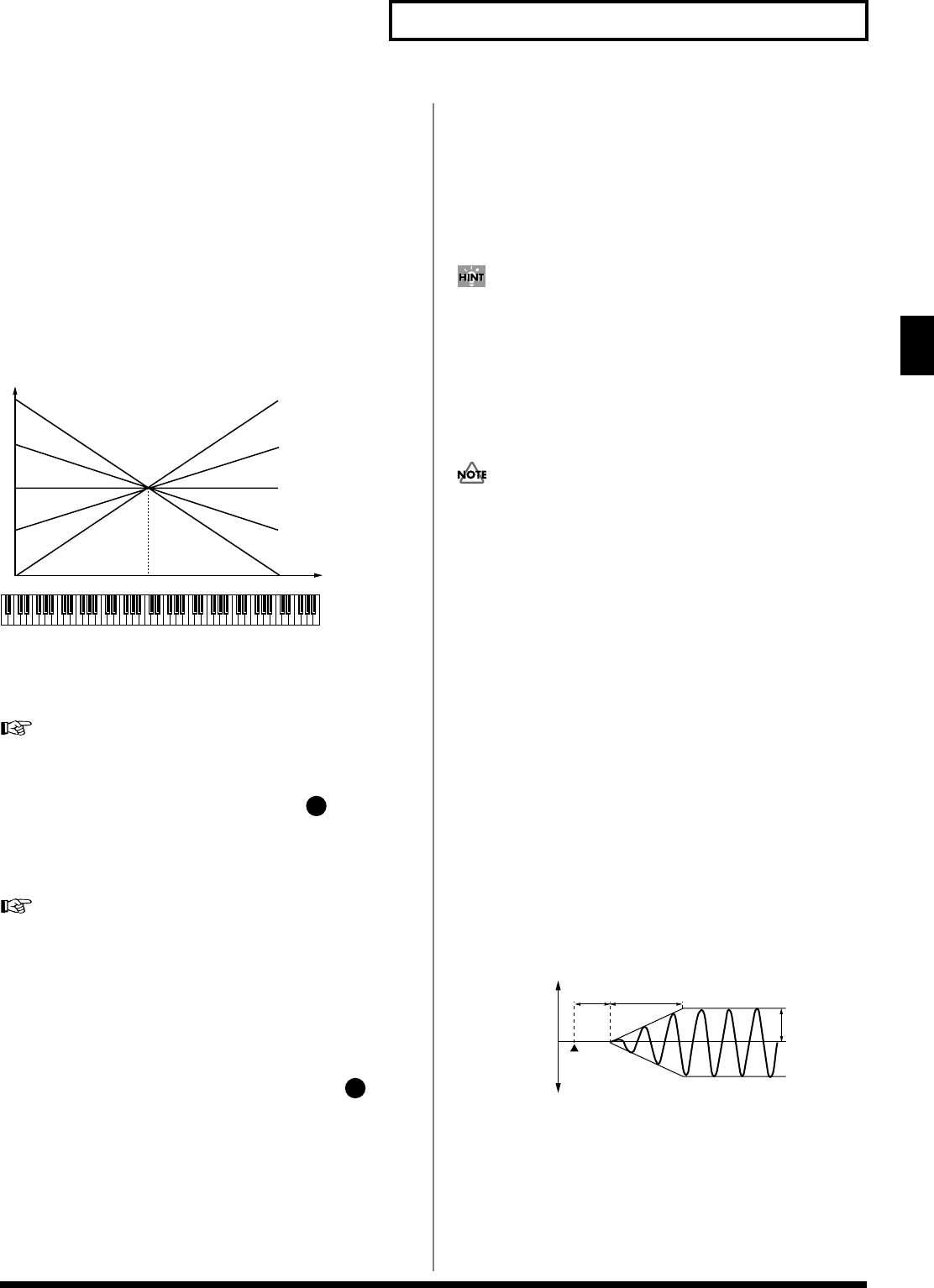
57
Creating a Patch
Creating a Patch
Delay Time KF
(LFO1/LFO2 Delay Time Key Follow)
Adjusts the value for the Delay Time parameter depending on the key
position, relative to the C4 key (center C). To decrease the time that
elapses before the LFO effect is applied (the effect is continuous) with
each higher key that is pressed in the upper registers, select a positive
value; to increase the elapsed time, select a negative value. Larger
settings will produce greater change. If you do not want the elapsed
time before the LFO effect is applied (the effect is continuous) to
change according to the key pressed, set this to “0.”
Value:
-100, -90, -80, -70, -60, -50, -40, -30, -20, -10, 0, +10, +20, +30,
+40, +50, +60, +70, +80, +90, +100
fig.Time KF.e
Fade Mode (LFO1/LFO2 Fade Mode)
Specifies how the LFO will be applied.
Value:
ON <, ON >, OFF <, OFF >
After referring to
“How to Apply the LFO”
(p. 57), change the
setting until the desired effect is achieved.
Fade Time (LFO1/LFO2 Fade Time)
Specifies the time over which the LFO amplitude will reach the
maximum (minimum).
Value:
0–127
After referring to
“How to Apply the LFO”
(p. 57), change the
setting until the desired effect is achieved.
Key Trigger (LFO1/LFO2 Key Trigger)
This specifies whether the LFO cycle will be synchronized to begin
when the key is pressed (ON) or not (OFF).
Value:
OFF, ON
Pitch Depth (LFO1/LFO2 Pitch Depth)
★
Specifies how deeply the LFO will affect pitch.
Value:
-63– +63
TVF Depth (LFO1/LFO2 TVF Depth)
★
Specifies how deeply the LFO will affect the cutoff frequency.
Value:
-63– +63
TVA Depth (LFO1/LFO2 TVA Depth)
★
Specifies how deeply the LFO will affect the volume.
Value:
-63– +63
Pan Depth (LFO1/LFO2 Pan Depth)
★
Specifies how deeply the LFO will affect the pan.
Value:
-63– +63
Positive (+) and negative (-) settings for the Depth parameter
result in differing kinds of change in pitch and volume. For
example, if you set the Depth parameter to a positive (+) value
for one tone, and set another tone to the same numerical value,
but make it negative (-), the modulation phase for the two tones
will be the reverse of each other. This allows you to shift back
and forth between two different tones, or combine it with the
Pan setting to cyclically change the location of the sound image.
When the Structure parameter is set to any value from “2”
through “10,” the output of tones 1 and 2 will be combined into
tone 2, and the output of tones 3 and 4 will be combined into
tone 4. This applies to the Pan Depth parameter settings. For this
reason, tone 1 will follow the settings of tone 2, and tone 3 will
follow the settings of tone 4 (p. 46).
Step LFO
LFO Step Type (LFO Step Type)
When generating an LFO waveform from the data specified in LFO
Step1–16, specify whether the level will change abruptly at each step
or will be connected linearly.
Value:
TYPE1 (stair-step change), TYPE2 (linear change)
Step 1–16 (LFO Step 1–16)
Specifies the data for the Step LFO. If the LFO Pitch Depth is +63,
each +1 unit of the step data corresponds to a pitch of +50 cents.
Value:
-36– +36
How to Apply the LFO
●
Apply the LFO gradually after the key is pressed
fig.LFO-1.e
Fade Mode:
ON <
Delay Time:
The time from when the keyboard is played until the
LFO begins to be applied.
Fade Time:
The time over which the LFO amplitude will reach the
maximum after the Delay Time has elapsed.
C4C3C2C1 C5 C6 C7
0
+50
+100
-50
-100
Key
Time
3
4
Note on
high (more)
low (less)
Pitch
Cutoff Frequency
Level
Pan
Delay
Time
Fade Time
Depth
Reference_e.book 57 ページ 2003年7月14日 月曜日 午後3時25分


















